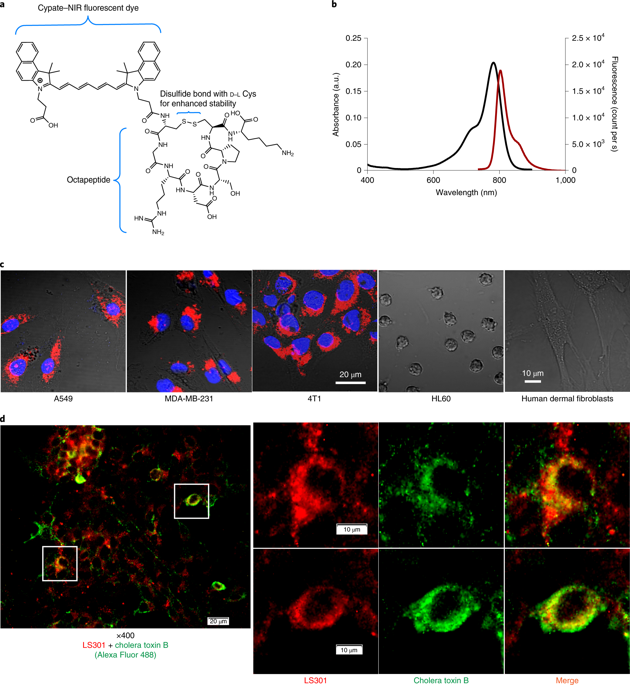当前位置:
X-MOL 学术
›
Nat. Biomed. Eng.
›
论文详情
Our official English website, www.x-mol.net, welcomes your
feedback! (Note: you will need to create a separate account there.)
Selective imaging of solid tumours via the calcium-dependent high-affinity binding of a cyclic octapeptide to phosphorylated Annexin A2.
Nature Biomedical Engineering ( IF 26.8 ) Pub Date : 2020-03-09 , DOI: 10.1038/s41551-020-0528-7 Duanwen Shen 1 , Baogang Xu 1 , Kexian Liang 1 , Rui Tang 1 , Gail P Sudlow 1 , Christopher Egbulefu 1 , Kevin Guo 1 , Avik Som 1, 2 , Rebecca Gilson 1, 2 , Dolonchampa Maji 1, 2 , Suman Mondal 1, 2 , LeMoyne Habimana-Griffin 1, 2 , Walter J Akers 1 , Shunqiang Li 3 , Yang Liu 1 , Sharon Bloch 1 , Sid Kurkure 1 , Zohar Nussinov 4 , Alexander Seidel 4 , Shaw-Wei D Tsen 1 , Samuel Achilefu 1, 2, 3, 5
Nature Biomedical Engineering ( IF 26.8 ) Pub Date : 2020-03-09 , DOI: 10.1038/s41551-020-0528-7 Duanwen Shen 1 , Baogang Xu 1 , Kexian Liang 1 , Rui Tang 1 , Gail P Sudlow 1 , Christopher Egbulefu 1 , Kevin Guo 1 , Avik Som 1, 2 , Rebecca Gilson 1, 2 , Dolonchampa Maji 1, 2 , Suman Mondal 1, 2 , LeMoyne Habimana-Griffin 1, 2 , Walter J Akers 1 , Shunqiang Li 3 , Yang Liu 1 , Sharon Bloch 1 , Sid Kurkure 1 , Zohar Nussinov 4 , Alexander Seidel 4 , Shaw-Wei D Tsen 1 , Samuel Achilefu 1, 2, 3, 5
Affiliation

|
The heterogeneity and continuous genetic adaptation of tumours complicate their detection and treatment via the targeting of genetic mutations. However, hallmarks of cancer such as aberrant protein phosphorylation and calcium-mediated cell signalling provide broadly conserved molecular targets. Here, we show that, for a range of solid tumours, a cyclic octapeptide labelled with a near-infrared dye selectively binds to phosphorylated Annexin A2 (pANXA2), with high affinity at high levels of calcium. Because of cancer-cell-induced pANXA2 expression in tumour-associated stromal cells, the octapeptide preferentially binds to the invasive edges of tumours and then traffics within macrophages to the tumour's necrotic core. As proof-of-concept applications, we used the octapeptide to detect tumour xenografts and metastatic lesions, and to perform fluorescence-guided surgical tumour resection, in mice. Our findings suggest that high levels of pANXA2 in association with elevated calcium are present in the microenvironment of most solid cancers. The octapeptide might be broadly useful for selective tumour imaging and for delivering drugs to the edges and to the core of solid tumours.
中文翻译:

通过环状八肽与磷酸化膜联蛋白A2的钙依赖性高亲和力结合,对实体瘤进行选择性成像。
肿瘤的异质性和连续遗传适应通过靶向基因突变使它们的检测和治疗复杂化。但是,癌症的标志,例如异常的蛋白质磷酸化和钙介导的细胞信号传导,提供了广泛保守的分子靶标。在这里,我们表明,对于一系列实体瘤,用近红外染料标记的环状八肽选择性结合磷酸化膜联蛋白A2(pANXA2),在高钙水平下具有高亲和力。由于癌细胞诱导的pANXA2在肿瘤相关基质细胞中的表达,八肽优先结合到肿瘤的浸润边缘,然后在巨噬细胞内运输到肿瘤的坏死核心。作为概念验证应用,我们使用八肽来检测肿瘤异种移植物和转移性病变,并在小鼠中进行荧光引导的手术肿瘤切除。我们的发现表明,大多数实体癌的微环境中都存在高水平的pANXA2与钙的升高。八肽可能广泛用于选择性肿瘤成像以及将药物递送至实体瘤的边缘和核心。
更新日期:2020-04-24
中文翻译:

通过环状八肽与磷酸化膜联蛋白A2的钙依赖性高亲和力结合,对实体瘤进行选择性成像。
肿瘤的异质性和连续遗传适应通过靶向基因突变使它们的检测和治疗复杂化。但是,癌症的标志,例如异常的蛋白质磷酸化和钙介导的细胞信号传导,提供了广泛保守的分子靶标。在这里,我们表明,对于一系列实体瘤,用近红外染料标记的环状八肽选择性结合磷酸化膜联蛋白A2(pANXA2),在高钙水平下具有高亲和力。由于癌细胞诱导的pANXA2在肿瘤相关基质细胞中的表达,八肽优先结合到肿瘤的浸润边缘,然后在巨噬细胞内运输到肿瘤的坏死核心。作为概念验证应用,我们使用八肽来检测肿瘤异种移植物和转移性病变,并在小鼠中进行荧光引导的手术肿瘤切除。我们的发现表明,大多数实体癌的微环境中都存在高水平的pANXA2与钙的升高。八肽可能广泛用于选择性肿瘤成像以及将药物递送至实体瘤的边缘和核心。











































 京公网安备 11010802027423号
京公网安备 11010802027423号